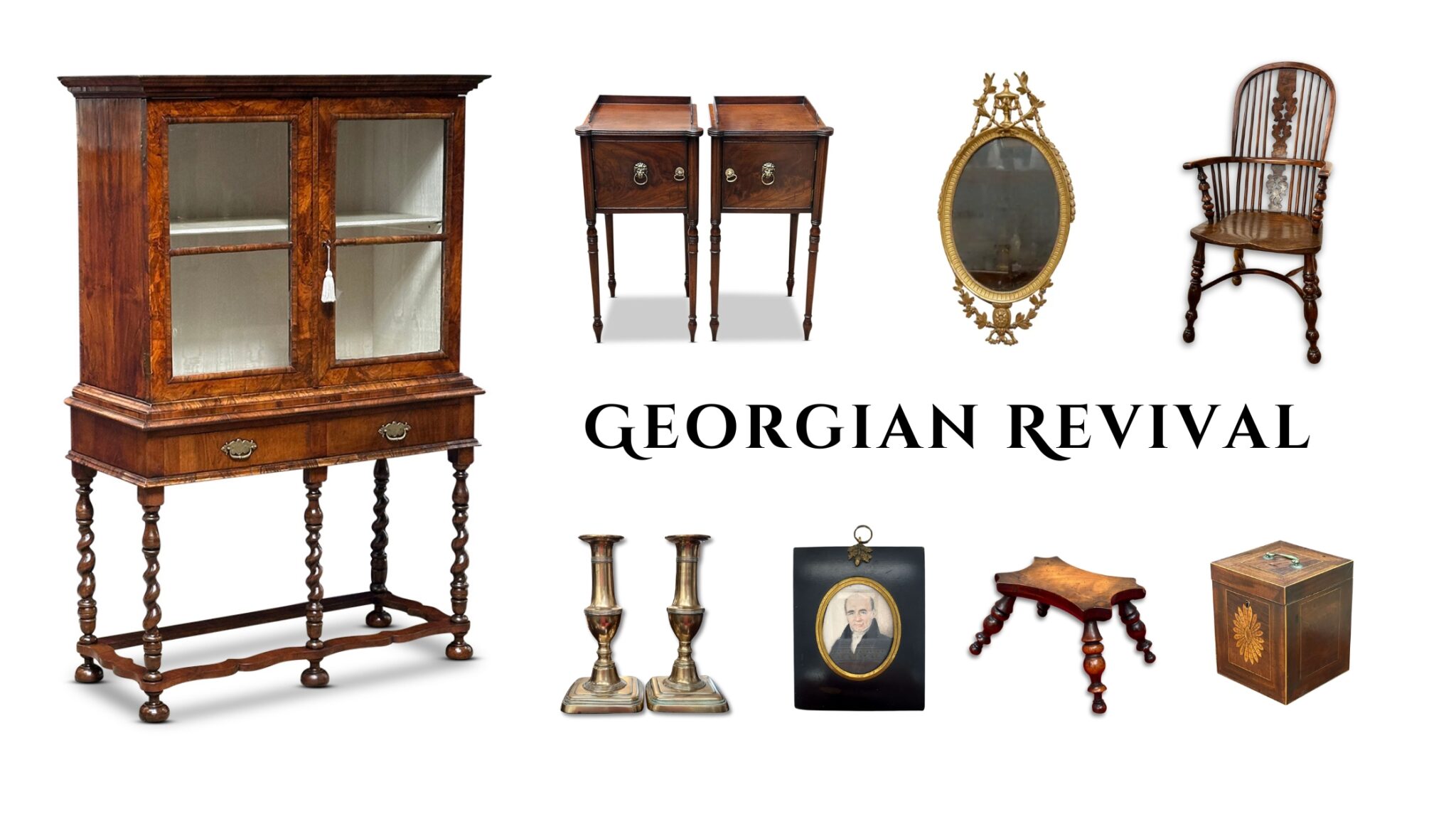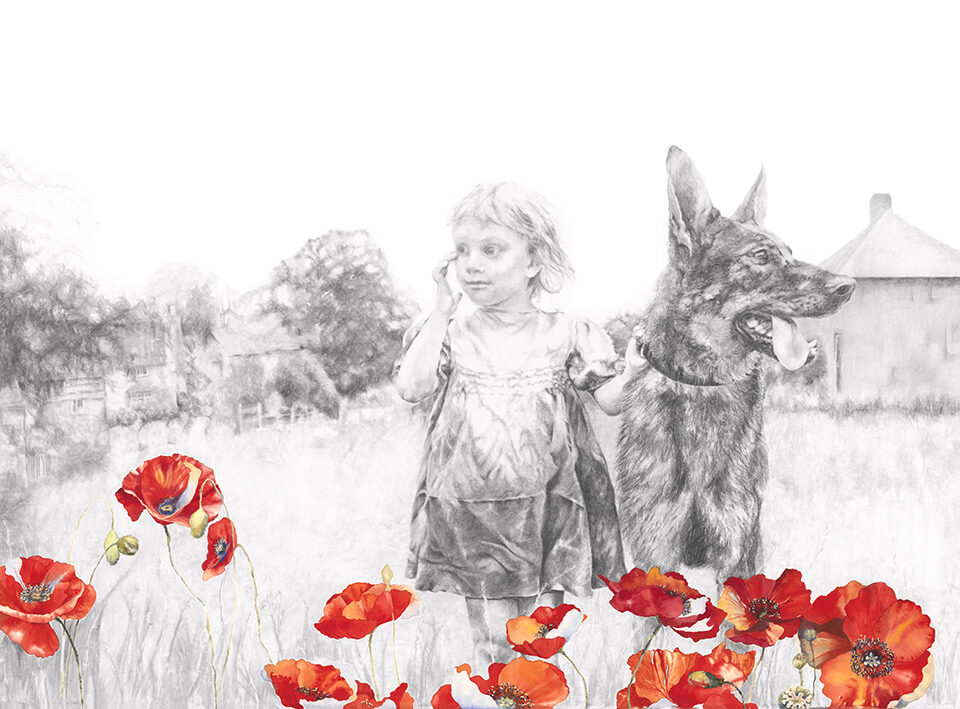
Australian Antiques and Art Dealers Association Sydney Fair 2024
15/10/2024
Landmark Buildings in Bendigo – Victor Rubin (1950 – )
31/01/2025Georgian Revival: The Rise of 18th Century Elegance in 2025 Interior Design

As we look toward 2025, interior design trends are shifting dramatically. While minimalist and modern styles have dominated in recent years, the elegance and artistry of Georgian furniture and art are making a grand resurgence. This classic aesthetic, which takes its name from the Georgian period of the early 18th century in England, is characterized by refined craftsmanship, symmetry, and graceful details that add character to any space. The revival of Georgian style represents a broader return to tradition, quality, and timeless design—values that are striking a chord in today’s fast-paced, technology-driven world.
An Introduction to Georgian Style: History and Characteristics
The Georgian period spans the reigns of four King Georges (1714-1830) and encompasses a time of prosperity and growth in Britain. This era saw a flourishing of architecture, furniture design, and art that embodied elegance, symmetry, and classical influences. Georgian style was influenced by the work of classical architects like Andrea Palladio and was marked by the use of high-quality materials, balanced proportions, and delicate details.
Key Features of Georgian Style:
- Symmetry and Proportion: Georgian design emphasizes harmony and balance, with symmetrical layouts in both architecture and furniture design.
- Craftsmanship: Georgian furniture was known for its meticulous craftsmanship, often created from high-quality woods like mahogany, walnut, and oak. Pieces were built to last, with an emphasis on durability and quality materials.
- Neoclassical Influence: The style was heavily influenced by classical Greek and Roman art, resulting in furniture and décor that were inspired by ancient forms, including fluted columns, acanthus leaves, and other Greco-Roman motifs.
- Ornate Details: Georgian furniture is known for intricate carvings, scrollwork, and decorative motifs. Pieces often include delicate embellishments like floral carvings, ball-and-claw feet, and shell motifs.
With these qualities, Georgian furniture and décor were designed not only to be visually pleasing but also to communicate a sense of stability, wealth, and refinement.
The Resurgence of Georgian Style in 2025
So why is Georgian style making such a powerful comeback? As we approach 2025, people are increasingly seeking ways to balance the hectic pace of modern life. This revival can be attributed to several key factors:
Return to Craftsmanship and Quality
With growing concerns about sustainability and mass production, there’s a renewed appreciation for handcrafted furniture made from durable materials. Georgian pieces are celebrated for their quality craftsmanship, a feature that appeals to contemporary homeowners who value longevity and environmental responsibility.
Timeless Appeal in a Changing World
In a world where trends can feel fleeting, the timeless appeal of Georgian style offers a sense of permanence and comfort. Its emphasis on symmetry, balance, and classical motifs resonates with people who crave stability and elegance in their homes.
Layered Aesthetic for Unique Spaces
The detailed craftsmanship and decorative elements of Georgian furniture add depth and texture to interiors, creating layered, multi-dimensional spaces. This approach offers a refreshing alternative to minimalism, with its emphasis on unique, eclectic decor that tells a story.
Key Elements of Georgian Furniture Making a Comeback
Modern Georgian-style interiors don’t necessarily recreate 18th-century spaces exactly but rather take inspiration from iconic Georgian furniture pieces, incorporating them in updated, contemporary ways. Here are some signature Georgian elements gaining traction:
Chippendale Chairs
The Georgian period was synonymous with Thomas Chippendale, a master craftsman whose chair designs became iconic. Chippendale chairs, known for their intricate latticework and elegant lines, are a staple in Georgian-inspired rooms. Modern interpretations feature updated fabrics and finishes, yet maintain the unmistakable Chippendale structure that exudes sophistication.
Cabinetry and Sideboards
Georgian furniture often included sideboards and cabinets with elaborate details, designed to display and store beautiful objects. In modern homes, these pieces are being used to add charm and storage to dining and living areas, providing functional yet stylish additions to the room.
Mahogany Tables and Writing Desks
The rich, dark finish of mahogany tables and desks is a hallmark of Georgian style. Today, designers are incorporating these classic pieces into home offices and dining spaces, pairing them with more contemporary elements to create a balance of tradition and modernity.
Ornate Mirrors and Gilt Frames
Georgian interiors frequently featured large mirrors and paintings in gilded frames. These pieces not only added a touch of opulence but also reflected light in a way that opened up the space. In 2025, designers are using these elements to create focal points on walls, embracing the luxurious feel that mirrors and gilded frames offer.
Georgian Art: Classical Inspiration and Revival
Art from the Georgian period was characterized by its attention to form, balance, and classical themes. Portraits and landscapes were popular subjects, often depicting aristocrats or pastoral scenes in a style that celebrated the order and beauty of nature.
Portraits in the Georgian Style
Georgian portraits are characterized by their detailed and realistic renderings, often with subjects in elegant attire, gazing thoughtfully into the distance. Modern designers are incorporating reproductions or reinterpretations of these portraits into contemporary spaces, where they bring an air of timeless sophistication.
Neoclassical Landscapes
Many Georgian homes featured landscapes with sweeping vistas and carefully composed scenes. These landscapes, influenced by the work of classical artists, are being revived as part of the Georgian trend, particularly in larger-scale paintings or as wallpaper murals that create a dramatic backdrop.
Detailed Moldings and Wall Panels
Georgian interiors were known for ornate architectural details, such as wainscoting, crown moldings, and paneling. These elements are reappearing in 2025 design as a way to add depth and texture to walls, contributing to the layered aesthetic of Georgian-inspired spaces.
Bringing Georgian Style into the Modern Home
While Georgian interiors of the 18th century were grand and stately, today’s Georgian revival is about balancing the traditional with the contemporary. Here are a few tips on how to integrate Georgian furniture and art into a modern home without creating a museum-like feel:
Mix Old and New
One of the keys to making Georgian style work in a modern space is to blend antique pieces with contemporary elements. For example, pairing a Georgian mahogany sideboard with a sleek, modern sofa creates contrast that feels fresh and inviting.
Embrace Rich Textures and Colors
Georgian style is known for its use of rich materials like velvet, brocade, and mahogany. To bring a Georgian-inspired look into your home, consider adding textures that invite a sense of warmth and elegance. Jewel tones like emerald green, royal blue, and burgundy are also ideal for adding drama.
Use Statement Art and Mirrors
Incorporate classic Georgian-style mirrors and paintings to add focal points. An oversized gilt mirror above a fireplace or a portrait in a contemporary dining room brings a unique layer of sophistication to any space.
Add Architectural Details
Consider incorporating paneling, molding, or wainscoting to add depth to your walls. This nod to Georgian design instantly transforms a space, adding an architectural quality that feels both classic and timeless.
Opt for a Symmetrical Layout
One of the hallmarks of Georgian style is symmetry. Try arranging furniture in balanced layouts that emphasize order and cohesion, which can help create a sense of calm and harmony.
The Future of Georgian Style
The revival of Georgian style in 2025 is about more than simply returning to an older aesthetic. It represents a broader shift towards a more intentional, sustainable approach to interior design. Georgian pieces are timeless, versatile, and adaptable, fitting comfortably in both traditional and contemporary settings. This enduring appeal suggests that Georgian style will remain popular well beyond 2025, as homeowners continue to seek designs that reflect quality, craftsmanship, and a connection to history.
As Georgian furniture and art gain traction as a trend-setting style, we’re reminded of the value in preserving and celebrating traditional design. This resurgence is proof that the elegance and artistry of the past can feel right at home in the present—and well into the future.
Whether you’re drawn to the intricate carvings of a Chippendale chair, the luxurious glow of a gilt mirror, or the classic beauty of a mahogany sideboard, Georgian style offers endless inspiration for creating a home that feels both elegant and timeless. So, as we look to 2025, it’s clear that the Georgian revival is here to stay, bringing a touch of history—and a wealth of style—into modern homes.





